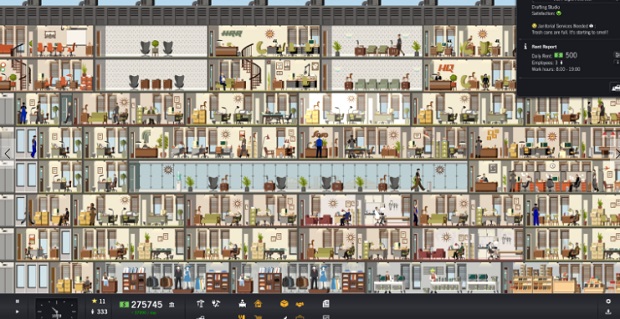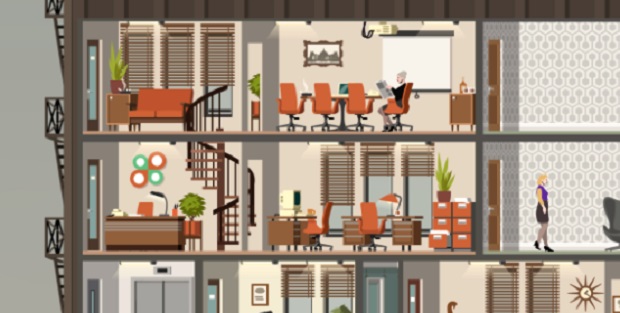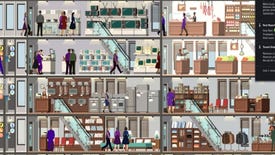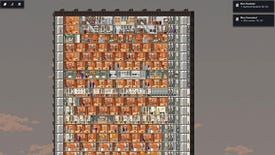Towering Above The Rest: Project Highrise
A non-Ballardian erection
There are many Sim games I'd like to see resurrected, prime among them SimEarth and SimLife, which were more enjoyable and educational than all of the geography classes I daydreamed through. SimTower is the outside pick though, its blend of construction and basic life sim making for a game as enjoyable to observe as to play.
Project Highrise [official site] is a new take on the formula and after spending some time building a tower of my own, I'm pleased to say Highrise as strong foundations, even if its occupants are a little plain.
First of all, here's what Project Highrise gets right: building a tower has all the satisfaction of constructing an intricate machine. This is a game that revels in connections, whether they come in the form of elevators, telephone wires or water pipes. Energy, people, waste and products all flow through the tower on routes, and around loops, that you design, using a simple suite of tools that are explained in tidy tutorials.
There's a lot of repetition involved. Every time you expand, especially when you're adding an entire new floor, you're going to need to hook up the basic services that your tenants expect. Depending on the kind of business they're running, or the quality of their living space if they're residents, they'll have different needs. An accountant doesn't require a courier service, for example, but a private detective agency does, to move sensitive documents around quickly and safely.
Some basic services, like telephone lines and electricity simply need a unit to be installed (usually in the basement, out of the way) and then cables can be drawn across the tower to hook up every office and apartment. Others, like the couriers, have their own offices. They don't have a happiness rating like your actual tenants but their placement within the building is important. Easy access for those who require them keeps things running smoothly.
New business types unlock as you play. You're unable to deliver what they need in the early stages and they'll only be attracted to a bustling tower, with lots of internal services and a good line in food stalls and other attractions. Actual apartment-dwelling residents are the most demanding of the first tier tenants. They want electricity AND running water AND a place to throw their trash, and they'll complain if they're in a busy part of the building with lots of passersby. They'll even complain if the recycling bins are too close to their homes. Because of the smell, y'see.
If you like overlays that show you exactly how noisy, busy or stinky every part of your tower is, Project Highrise will serve you well. All of the data you need are available with a couple of clicks and the tower's inhabitants will tell you what's bothering them, and what's pleasing them, when you select them. I particularly liked being able to see exactly how many meals a bagel stall had sold in a day, as well as how many regular customers it had managed to capture.
All of those details have an immediate impact. Unhappy people will take their business, or lives, elsewhere, and while office workers demand a variety of takeaway food options, the businesses themselves don't particularly enjoy the competition. The bagel man became unhappy when I installed a burger lady closer to the entrance and immediately shifted half of his business to her. A couple of days later, she was stealing his regulars, the placement of her stall near the front of the building attracting people as they entered and exited. Bagels required a little more effort.
There's a story in that little sequence, of the frustrated bageleer and the triumphant burger queen. Project Highrise doesn't tell the story though – it's too busy tracing all the flow of cash, smell and sound – and it doesn't provide a great deal of flavour with which to spice up the story that you tell to yourself. It's lovely that there are different variations of the basic businesses, and every single one is named, but they don't have any of the visual style that you can find in something like Tiny Tower.
Now, I'd rather have the detailed simulation of Project Highrise than the shallow tapping of Tiny Tower, but where Highrise falls down, it's in the character department. There are systems that I didn't have time to unpick that allow for redecoration and the installation of art and fancy furniture, and what little I saw of them goes some way to making the towers more attractive, but this is a game that admires function more than form. To that end, even aesthetic improvements are more important in terms of the effect that they have on inhabitants rather than the effect they have on the tower as an actual thing that you, the player, are looking at.
I'll need to play the game for many more hours before I can figure out whether the actual construction and management has enough complications to make it challenging, but a brief look strongly suggestst that this is a game for people who enjoy making a machine rather than engaging with the lives of the people within the machine. I was hypnotised, happily serving the needs of everyone who set foot within my erection and trying to ensure they left satisfied at the end of the day. Project Highrise puts you to work.
There's enjoyment to be found in that work and I look forward to making a magnificent building, with all the conflicting demands of its tenants requiring tricky decision-making rather than simple allocation of resources. If you're looking for a game that simulates life as well as work, Project Highrise may not be for you. But if you're hoping for a vertical version of Factorio, more concerned with the inner workings of the building than its inner life, then Highrise might be just what you've been waiting for.














